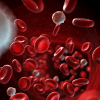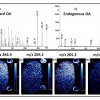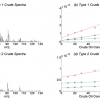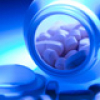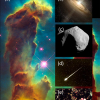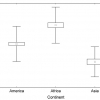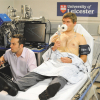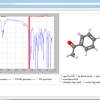Wolfgang Schulza and André Schreiberb
aLaboratory for Operation Control and Research, Landeswasserversorgung, Germany. E-mail: [email protected]
bAB SCIEX, Concord, Ontario, Canada
Introduction
The Landeswasserversorgung (LW) is one of the largest water supply companies in Germany; it is responsible for providing safe drinking water to more than 250 cities across the south-west of the country. LW supplies up to 450,000 m3 per day (6500 s–1) to its 3 million customers, taken from three different raw water resources: ground water (from the Danube marshland), spring water (Egau waterworks) and the River Danube. Raw water is extracted from these sources and pumped to one of LW’s waterworks in Langenau or Dischingen, for rigorous treatment and testing in order to produce the highest quality drinking water. Water from the River Danube, for example, passes through six stages, beginning with two pre-treatment plants for the removal of humic and clouding materials, followed by the oxidative removal of flavours and odorous substances and oxidation and disinfection of the water at an ozone plant. The water then undergoes a dual-layer filtration process (with hydroanthracite and sand) to remove residual suspended substances, followed by activated carbon filtering, which removes the smallest particles of organic contaminants. Finally, the water is disinfected with chlorine dioxide as a security measure to keep the drinking water safe during transportation to the consumer.
Drinking water is strictly regulated and the German Drinking Water Ordinance requires over 100 individual parameters to be inspected. For the LW, this amounts to over 300,000 separate analyses per year, for which the LW runs its own Laboratory for Operation Control and Research (LOCR) at the Langenau waterworks site. This laboratory is responsible for chemical, physico–chemical and microbiological analyses, provided by around 30 staff. The analyses include monitoring pH, water hardness, microbiological contaminants (for example, coliform bacteria, E. coli, Enterococcus, and colony count) and inorganic and organic parameters. The laboratory uses a range of chromatography and spectrometry-based techniques to monitor and profile levels of contaminants in raw and treated water (see Table 1). The laboratory has particular expertise in organic trace analysis, using gas chromatography (GC) and liquid chromatography (LC) coupled with mass spectrometry, GC-MS and LC-MS, respectively, to monitor the presence of hundreds of organic contaminants that are routinely found in water, including pesticides, industrial chemicals, pharmaceuticals and their by-products. These contaminants can find their way into water sources directly and indirectly, such as through landfill leachates or accidents and via wastewater treatment plants.
Table 1. Range of techniques used by the LW to monitor levels of contaminants in raw and treated water.
Class | Examples | Analysis method |
Inorganic compounds | ||
Anions | Sulfate, chloride, nitrate | Ion chromatography |
| Phosphate, ammonium, | Photometry |
Cations and heavy metals | Calcium, magnesium, sodium, potassium, iron , chromium, copper, uranium | ICP-MS |
Organic compounds | ||
Pesticides & metabolites | Carbofuran, | LC/MS and GC/MS |
Organic chlorine compounds | PCB, lindane | |
Industrial chemicals | Benzotriazoles | |
Pharmaceuticals | Sulfadiazene, carbamazepine, sulfamethoxazole, iodinated x-ray contrast media | |
Aromatic compounds | Benzene, xylene | |
Volatile halogenated compounds | Benyzl chloride trichloroethene, chloroform, chloroethene | |
Complexing agents | EDTA | |
The LW tries to identify all organic substances at trace-level concentrations in its water sources. This approach has a number of challenges: in particular, many of the compounds are present at only very low concentrations, meaning the analytical methods must be extremely sensitive, but also able to detect diverse compounds, including those with low or high polarity. Another challenge is coping with the vast number of contaminants (hundreds or thousands) that may be present in any given sample. Finally, a major challenge is the question of how to detect and identify contaminants that are not necessarily expected to be present, both rapidly and cost-effectively.
Non-target and multi-target screening
In general, there are two different approaches to MS-based screening: non-target screening (NTS, also known as general unknown screening) and multi-target screening. For NTS, a single survey scan is carried out over a defined mass range to discover which compounds are present in a sample, prior to their identification and quantification. This is commonly used when monitoring environmental samples, for example, that may contain a large number of diverse, unknown contaminants.
The MS survey scan could be a time-of-flight (ToF), a quadrupole or an ion trap scan, although high-resolution instruments such as ToF are generally used for NTS procedures, due to their better signal-to-noise (S/N) ratio in scanning mode. The scan can automatically trigger the acquisition of a product ion spectrum if a detected compound’s signal is above a defined threshold. This spectrum can then be searched against a mass spectral library for identification. Comparison of the total ion chromatograms (TIC) of unknown samples to that of the control reveals compounds that are either unique to the sample, or those that are present at significantly higher concentrations than in the control. Thus, the aim of NTS is to detect all substances that are accessible to the particular analysis technique, with a focus on unexpected or unknown substances.
Multi-target screening, in contrast, searches for a predefined list of compounds in a multiple reaction monitoring (MRM) or single ion monitoring (SIM) experiment. MRM mode is generally preferred for targeted screening because of its higher selectivity and sensitivity and high S/N.1,2 This allows direct quantification of target analytes at the ng L–1 range, without the need for prior enrichment.3 Once a compound is detected above a defined threshold, a product ion scan is collected and compared against a mass spectral library to enhance confidence in detection.
Developing non-target screening for water quality testing
Scientists at LW perform NTS using LC-ToF-MS/MS, using software to identify all peaks present in a sample after non-targeted data acquisition. When a non-targeted, unexpected compound is discovered, it is important to be able to subsequently confirm and identify that compound, therefore the mass spectrometer must be sufficiently sensitive to detect and identify the compound directly, while at the same time having high mass accuracy for components present at very low concentrations.
The LW started developing LC-ToF-MS/MS-based methods combined with electrospray ionisation (ESI) for non-target screening about five years ago. The approach has the advantage of providing information on all organic substances in a sample that are detectable with this system; however, there were also a number of disadvantages that the scientists are in the process of addressing.
The main issue was sensitivity, and a sample preparation step—solid phase extraction (SPE)—had to be included, which leads to interferences. These had to be removed by blank subtraction during NTS, which was not straightforward since, initially, the LOCR didn’t have software capable of performing the required calculations.
Other challenges to overcome included the difficulties of data analysis, the need for multivariate statistical methods, and the need for standardised procedures, particularly with the large amount of data that NTS generates. Finally, improved methods were needed for identification of detected compounds, particularly when interpreting accurate mass MS/MS data. The LOCR’s researchers have spent several years overcoming these problems, and have recently published a more sensitive, fast and powerful general screening method that allows rapid comparison between samples and identification of relevant compounds from the vast data generated.4
As an initial step, the scientists developed a highly sensitive LC-MS/MS multi-targeted screening method using a QTRAP 5500 System (AB SCIEX, USA), that allowed direct injection of the water sample into the LC system, without the need for pre-concentration.3 Since then, new ToF technology (such as the Triple TOF 5600, AB SCIEX) with higher mass resolution and high scan speeds has been used that allowed further method improvement. Another advance was brought about by new, faster software and algorithms for peak finding and comparing samples.
The new approach consists of three steps: screening/data evaluation, database-assisted identification of organic substances (DAIOS, see below) and verification of transformation products. Samples (100 µL) are analysed using direct injection ToF mass spectrometry, with the following settings: gas 1 40 psi, gas 2 50 psi, curtain gas 40 psi, temperature 550°C, Voltage +5500 V resp. –4500 V; scan range 50–050 m/z. The resolution power was >38,000 at 922.0097 m/z and >20,000 at 121,0508 m/z for ESI+, and >38,000 at 980.0164 and >22,000 at 119.0363 for ESI–.
The higher resolution of new ToF technology makes it possible to generate full sample scans, very rapidly. Speed is really important with such vast datasets and it is now possible to detect and analyse information that could not be obtained previously. The software then produces mass vs retention time scatter plots (see Figure 1), which represent all the organic trace substances in the sample that are recognised by the method.

A critical factor of this new approach is to be able to differentiate between information that is identical across different samples and information that is different, such as the presence of a new compound in a sample. This is achieved by selecting compounds to be submitted for further identification on the basis of their likely relevance, based on set theory. The number of compounds detected in a sample can vary from tens to hundreds, but when comparing samples with a temporal or spatial relationship, it is possible to match and remove common features across all samples—i.e. those individual compounds with the same retention time and exact mass (Figure 1).
All the detected compounds of the different samples are evaluated through the following process:4 (1) all detected compounds are used for the data evaluation. The detection of substances or substance groups is only limited by the applied analytical technique; (2) the compounds of a sample are considered as mathematical sets, so all compounds can be compared across samples using set operators (union, intersect and complement) to determine which compounds are of interest; (3) all compounds detected above a given intensity threshold are treated as having equal intensities during data evaluation. However, when the data undergo further investigation, such as using principal component analysis (PCA), the intensities are included. The method also introduced the DAIOS database for identification of compounds from aquatic environments.5 DAIOS includes functions such as product ion search to increase the efficiency of the database query after screening and the transformation tree function to identify related transformation products.
The sensitivity, speed, power and utility of the new method are described by Müller et al.4 (see Figures 2 and 3). For example, it was demonstrated that 1729 compounds were detected in a landfill leachate sample and, in just one step, all of these could be evaluated for their potential contamination of drinking water by comparing them with the compounds detected in a groundwater sample [groundwater well (GW A)], in untreated water and finally in the treated drinking water, having subtracted out those compounds in the reference blank (GW B). It was shown that only eight of these compounds were present in the raw water (Figure 3), therefore 1721 out of 1729 were not relevant. After treating the water with ozone, three of the eight compounds were found in the drinking water.


The method was able to identify the structures of these three compounds from their MS/MS spectra as 1-adamantylamine, carbamazepine and crotamiton (see Figure 4, (a)–(c), respectively), present in the drinking water at concentrations in the range of 20 ng L–1. Eleven further substances and degradation products were also identified in the leachate sample, through the DAIOS’ capabilities for identifying transformation products.
It would have been very difficult to obtain such information without the new method approach. It indicates which compounds may be important, obtains their exact masses, generates their formulae, detects the structures, identifies the compounds and confirms they are contaminants in the aquatic environment.



Conclusions and future directions
Direct injection LC-ToF-MS/MS analysis of organic contaminants in water is a fast and powerful analytical tool for general screening and, using the latest MS systems, it is possible to detect compounds with limits of detection in the ng L–1 range. Combining this technique with chemometric statistical analysis provides a reliable peak-finding algorithm that is important for non-target screening. Further data analysis can be carried out using PCA to find relevant compounds, and samples can be compared rapidly using t-tests. The cost-effectiveness of this approach is likely to lead to its widespread use in many such applications in the future.
The use of high-resolution and accurate mass MS/MS is likely to become increasingly important in water quality testing. This approach could be used in other water quality applications, such as open and groundwater monitoring in remediation of contaminated sites, or for monitored natural attenuation, as well as for evaluating the process steps during drinking water treatment and for following the impact of extended waste water treatment.
References
- D. Barcélo and M. Petrovic, “Challenges and achievements of LC-MS in environmental analysis: 25 years on”, Trends Anal. Chem. 26, 2–11(2007). doi: 10.1016/j.trac.2006.11.006
- M. Krauss, H. Singer and J. Hollender, “LC–high resolution MS in environmental analysis: from target screening to the identification of unknowns”, Anal. Bioanal. Chem. 397, 943–951(2010). doi: 10.1007/s00216-010-3608-9
- W. Seitz, W. Schulz and W.H. Weber, “Novel applications of highly sensitive liquid chromatography/mass spectrometry/mass spectrometry for the direct detection of ultra-trace levels of contaminants in water”, Rapid Commun. Mass Spectrom. 20, 2281–2285 (2006). doi: 10.1002/rcm.2554
- A. Müller, W. Schulz, W.K.L. Ruck and W.H. Weber, “A new approach to data evaluation in the non-target screening of organic trace substances in water analysis”, Chemosphere 85, 1211–1219 (2011). doi: 10.1016/j.chemosphere.2011.07.009
- See: http://www.docstoc.com/docs/10771791/Database-Assisted-Identification-of-Organic-Substances-(DAIOS and http://www.lw-online.de/fileadmin/downloads/service_fachbeitraege/7_Poster_DAIOS.pdf (Accessed 27 September 2011).




